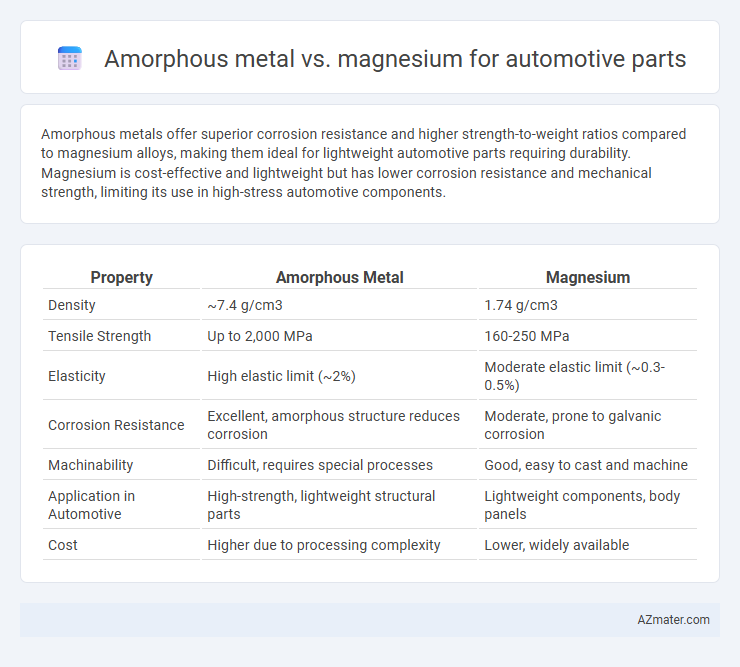Amorphous metals offer superior corrosion resistance and higher strength-to-weight ratios compared to magnesium alloys, making them ideal for lightweight automotive parts requiring durability. Magnesium is cost-effective and lightweight but has lower corrosion resistance and mechanical strength, limiting its use in high-stress automotive components.
Table of Comparison
| Property | Amorphous Metal | Magnesium |
|---|---|---|
| Density | ~7.4 g/cm3 | 1.74 g/cm3 |
| Tensile Strength | Up to 2,000 MPa | 160-250 MPa |
| Elasticity | High elastic limit (~2%) | Moderate elastic limit (~0.3-0.5%) |
| Corrosion Resistance | Excellent, amorphous structure reduces corrosion | Moderate, prone to galvanic corrosion |
| Machinability | Difficult, requires special processes | Good, easy to cast and machine |
| Application in Automotive | High-strength, lightweight structural parts | Lightweight components, body panels |
| Cost | Higher due to processing complexity | Lower, widely available |
Introduction to Amorphous Metals and Magnesium in Automotive Applications
Amorphous metals, known for their non-crystalline atomic structure, offer superior strength, corrosion resistance, and wear resistance compared to traditional metals, making them ideal for high-performance automotive parts. Magnesium, valued for its low density and excellent strength-to-weight ratio, is widely used to reduce vehicle weight and improve fuel efficiency. Both materials contribute to automotive innovation by enhancing durability and lightweight design, with amorphous metals excelling in structural applications and magnesium favored for components requiring significant weight savings.
Material Composition and Structure Comparison
Amorphous metals, also known as metallic glasses, feature a non-crystalline atomic structure that imparts superior strength and corrosion resistance compared to the crystalline structure of magnesium alloys commonly used in automotive parts. Magnesium alloys consist primarily of magnesium with aluminum, zinc, and other elements forming a hexagonal close-packed (HCP) crystalline lattice, which offers lightweight properties but lower mechanical strength than amorphous metals. The disordered atomic arrangement of amorphous metals reduces dislocation movement, enhancing wear resistance and fatigue life, whereas magnesium's crystalline structure can be more prone to deformation and corrosion under stress.
Mechanical Properties: Strength, Ductility, and Toughness
Amorphous metals exhibit superior strength and hardness compared to magnesium alloys, making them ideal for high-stress automotive parts requiring enhanced wear resistance. Despite their high strength, amorphous metals typically have lower ductility, whereas magnesium alloys offer excellent ductility but with reduced toughness and lower impact resistance. The toughness of magnesium is generally higher due to its ability to deform plastically, while amorphous metals provide enhanced fatigue resistance, critical for long-term automotive applications.
Corrosion Resistance and Environmental Durability
Amorphous metals exhibit superior corrosion resistance compared to magnesium alloys, thanks to their non-crystalline atomic structure that reduces grain boundaries prone to corrosion. Magnesium, while lightweight and cost-effective, is highly susceptible to oxidation and pitting in automotive environments, requiring protective coatings to enhance durability. The enhanced environmental durability of amorphous metals makes them ideal for automotive parts exposed to harsh conditions, extending service life and reducing maintenance costs.
Weight Reduction Benefits for Vehicle Design
Amorphous metals offer superior weight reduction benefits compared to magnesium for automotive parts due to their higher strength-to-weight ratio and enhanced corrosion resistance. These materials allow for thinner, lighter components without sacrificing durability, contributing to improved fuel efficiency and performance. The ability of amorphous metals to be precision-molded into complex shapes further supports innovative, lightweight vehicle design solutions.
Manufacturing Processes and Cost Efficiency
Amorphous metal in automotive parts offers superior strength and corrosion resistance through rapid solidification manufacturing processes like melt spinning, though these methods can be cost-intensive due to specialized equipment and slower production rates. Magnesium parts benefit from established casting and extrusion techniques that provide lightweight solutions with high-volume manufacturing efficiency and lower material costs. Evaluating cost efficiency, magnesium typically presents a more economical option for mass production, while amorphous metals excel in performance-critical components despite higher initial costs.
Performance in Crashworthiness and Safety
Amorphous metals exhibit superior crashworthiness compared to magnesium due to their higher strength-to-weight ratio and enhanced energy absorption capabilities, which significantly improve impact resistance in automotive parts. These materials demonstrate exceptional ductility and fatigue resistance, reducing the likelihood of catastrophic failure during collisions. Magnesium alloys, while lightweight, typically have lower fracture toughness and are more prone to brittle fractures, making amorphous metals a safer choice for critical structural components in vehicle safety systems.
Thermal Conductivity and Heat Resistance
Amorphous metals exhibit superior heat resistance compared to magnesium, maintaining structural integrity at higher temperatures due to their non-crystalline atomic arrangement, which enhances thermal stability. Magnesium offers higher thermal conductivity, facilitating faster heat dissipation but suffers from lower melting points and susceptibility to oxidation, limiting its use in high-temperature automotive components. The choice between amorphous metal and magnesium depends on the application's need for heat resistance versus efficient thermal conduction in automotive parts such as engine covers and heat shields.
Sustainability and Recycling Considerations
Amorphous metals offer superior corrosion resistance and longer lifespan compared to magnesium, enhancing sustainability by reducing material replacement frequency in automotive parts. Magnesium is lightweight and highly recyclable, with an established recycling infrastructure that lowers energy consumption and greenhouse gas emissions during material recovery. The choice between amorphous metals and magnesium impacts the automotive industry's environmental footprint, with amorphous metals providing durability advantages and magnesium facilitating efficient circular material flows.
Future Trends and Industry Adoption
Amorphous metals offer superior strength, corrosion resistance, and energy absorption, positioning them as promising materials for lightweight automotive parts in electric and autonomous vehicles. Magnesium remains a cost-effective, lightweight option widely used in current automotive manufacturing, especially for structural components, but faces challenges related to corrosion and mechanical properties. Future industry adoption is expected to increase for amorphous metals as advancements reduce production costs and improve scalability, while magnesium will continue to dominate in applications where cost efficiency and recyclability are prioritized.

Infographic: Amorphous metal vs Magnesium for Automotive part
 azmater.com
azmater.com